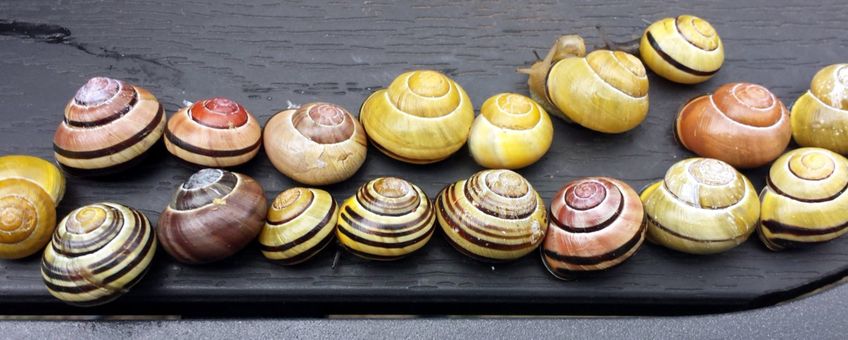
Hot cities shape snail evolution
Naturalis Biodiversity CenterThe living conditions in cities influence the evolution of urban-dwelling plant and animal species. So-called urban heat islands, pockets of higher temperatures in the city center resulting from a combination of generated, reflected and stored warmth, are one such environmental factor.
 Menno Schilthuizen and Niels Kerstes, together with their colleagues and a large number of citizen scientists, looked at urban evolution among garden snails. "We received nearly 8,000 photos of garden snails sent in by citizen scientists, often via our Snailsnap app, a joint Naturalis, Waarneming.nl and EIS Kenniscentrum Insecten initiative”, Niels Kerstes explains. “We sorted the snails based on the color of their shells and the number of dark bands running across them. We also had location data for every photo, which allowed us to link the snails’ color and band markings to environmental factors: urban/non-urban setting, temperature, precipitation and urban heat islands. It tends to be warmer in cities than in the surrounding areas.
Menno Schilthuizen and Niels Kerstes, together with their colleagues and a large number of citizen scientists, looked at urban evolution among garden snails. "We received nearly 8,000 photos of garden snails sent in by citizen scientists, often via our Snailsnap app, a joint Naturalis, Waarneming.nl and EIS Kenniscentrum Insecten initiative”, Niels Kerstes explains. “We sorted the snails based on the color of their shells and the number of dark bands running across them. We also had location data for every photo, which allowed us to link the snails’ color and band markings to environmental factors: urban/non-urban setting, temperature, precipitation and urban heat islands. It tends to be warmer in cities than in the surrounding areas.
The researchers found that, on average, snails found in warmer locations were lighter in color and the percentage of yellow snails was greater in places where higher temperatures occur. This means that more yellow snails were found in urban areas and in spots where the effect of an urban heat island was more strongly felt. Moreover, yellow snails in warmer locations were also more likely to have bands on the underside of their shell and fewer bands on the top. “These results correspond to the predicted effect of the urban environment on the evolution of the snail houses,” according to Kerstes. “Yellow snails are lighter in color than the pink or brown members of their species, making them better able to withstand hot, dry conditions. The yellow color reflects the most sunlight, causing the snails to heat up less quickly.”
Kerstes and Schilthuizen plan to continue their citizen science project concerning urban evolution through the Evoscope project. Funded by the municipality of Leiden and Naturalis, the project will include experiments involving snails, great tits, jackdaws and dandelions. Through effective identification of the ways plants and animals adapt to meet the challenges of city life, it is possible to establish just how quickly and efficiently evolution can occur. Such efforts also provide insight into how cities might be redesigned to improve the lives of the plants, animals and people.
The article in Biology Communications is available online.
Text: Naturalis Biodiversity Center
Photo's: Naturalis Biodiversity Center; SnailSnap
